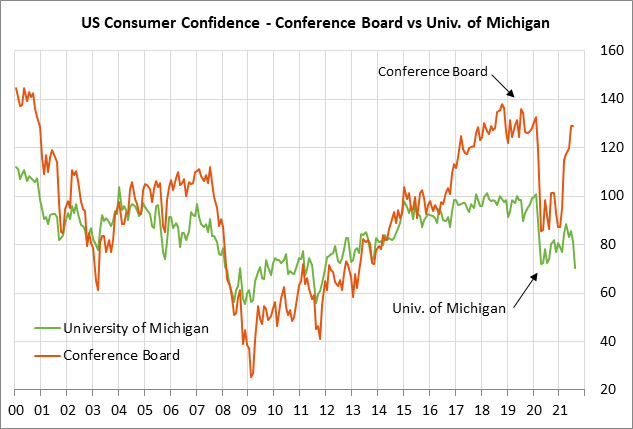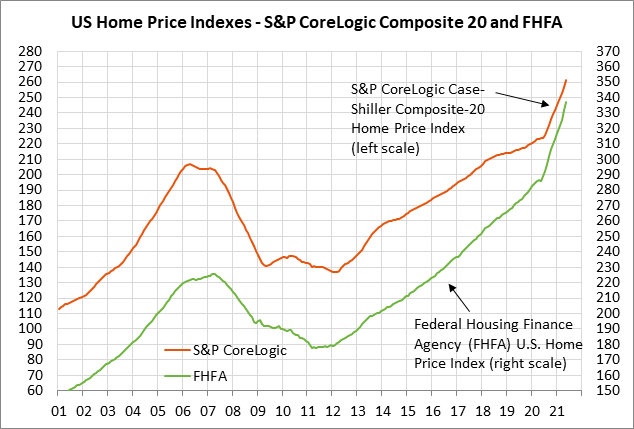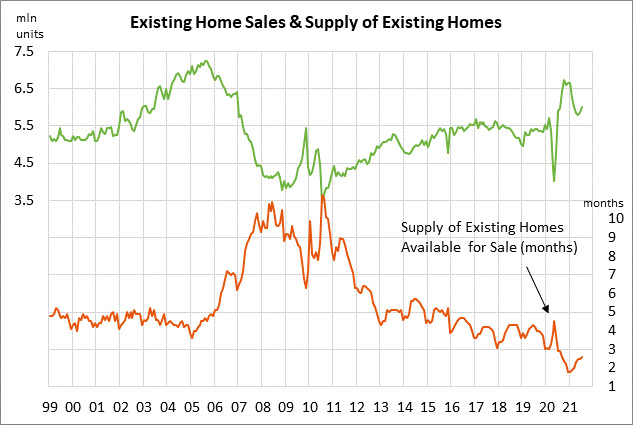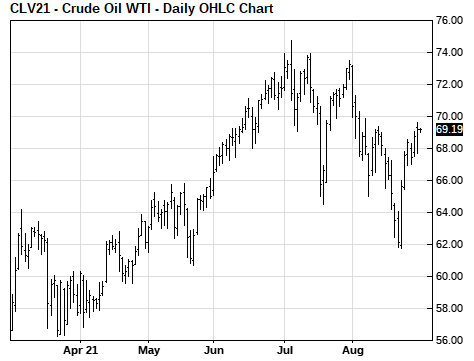- Aug U.S. consumer confidence expected to drop
- U.S. home prices expected to show another surge in June
- Hurricane Ida has a limited bullish impact on petroleum markets
Aug U.S. consumer confidence expected to drop — The consensus is for today’s Conference Board U.S. Aug consumer confidence index to show a sharp -6.1 point drop to 123.0, more than reversing July’s small gain of +0.2 to 129.1.
Expectations for a decline in today’s Conference Board report are based in part on the already-reported news that the University of Michigan’s U.S. consumer sentiment index in August plunged by -10.9 points to a new 10-year low of 70.3, taking out even the previous pandemic low seen in April 2020.
Consumers are clearly alarmed by the resurgence of the pandemic and the return of some pandemic restrictions. Consumers are also reacting negatively to the surge in inflation and high gasoline prices, which are taking a bite out of their wallets.
However, there is room for consumer sentiment to improve in coming months since the economic outlook is much better than it was in April 2020 when the pandemic first hit. The Fed and the U.S. government over the past 1-1/2 years have pumped the U.S. economy full with massive amounts of monetary and fiscal stimulus, and the U.S. economy is growing so fast that it has run into many supply obstacles.
The resurgence of the pandemic is clearly a major disappointment, but as the vaccination levels continue to improve, the pandemic should still fade going into next year and allow a more normal economy and labor market to emerge, thus boosting consumer confidence.


U.S. home prices expected to show another surge in June — The consensus is for today’s U.S. home price reports to show another monthly surge. The consensus is for today’s June FHFA house price index to show a +1.9% m/m increase, adding to May’s +1.7% increase.
Meanwhile, today’s June S&P CoreLogic composite-20 home price index is expected to surge by +1.8% m/m and +18.6% y/y, which would be similar to May’s increase of +1.8% m/m and +17.0% y/y.
U.S. home prices continue to see an upward squeeze due to the combination of strong demand and tight supplies. Home prices have shown double-digit increases on a year-on-year basis every month this year. From the pre-pandemic level seen in December 2019, the FHFA index has risen by a total of 20% and the Composite 20 index has risen by a total of +19%.
While it seems unlikely that home prices will drop over the next year, there are reasons to think that home prices will at least moderate since more houses are starting to come onto the market. The supply of existing homes on the market rose to an 11-month high of 2.6 months in July. That was still tight compared to the pre-pandemic level of 3.0 months but at least indicated that supply has increased relative to the record low of 1.8 months seen earlier this year in December and January.
Also, existing home sales have cooled off a bit to 5.99 million units from the 15-year high of 6.73 million seen in October 2020. Home sales have cooled in part because of resistance to the surge in home prices. Potential home-buyers are turning more cautious since they don’t want to be left holding the bag by buying a home at what could be near the peak of the pandemic bubble.


Hurricane Ida has a limited bullish impact on petroleum markets — Oct WTI crude oil and Oct RBOB gasoline prices on Monday settled moderately higher, with crude at a 3-week high and gasoline at a 1-month high. October WTI crude oil (CLV21) on Monday closed up +0.47 (+0.68%), and October RBOB gasoline (RBV21) closed up +0.0342 (+1.61%).
Crude prices rallied to a 3-week high Monday after the Bureau of Safety and Environmental Enforcement reported that about 1.74 million bbl of U.S. crude production was shut-in as of Sunday due to Hurricane Ida, which made landfall in Louisiana on Sunday. The Gulf of Mexico produces 16% of total U.S. crude production, and the Gulf Coast is home to 48% of total U.S. refining capacity.
Crude prices fell back from their best levels Monday on speculation that refinery demand for crude along the U.S. Gulf Coast will be weak as refiners remain shut down from Hurricane Ida. Also, oil production should be able to resume fairly quickly due to reports that hurricane damage was minor to U.S. oil platforms in the Gulf of Mexico.
However, there will be a lingering bullish impact on gasoline prices in the Eastern U.S. because the Colonial Pipeline was idled due to Hurricane Ida. The Colonial Pipeline is the largest fuel distribution system delivering gasoline from the refining centers along the Gulf Coast to customers across the eastern U.S. The pipeline will take a number of days to get back in gear, meaning that the Eastern U.S. could see some fuel shortages over the next couple of weeks.

